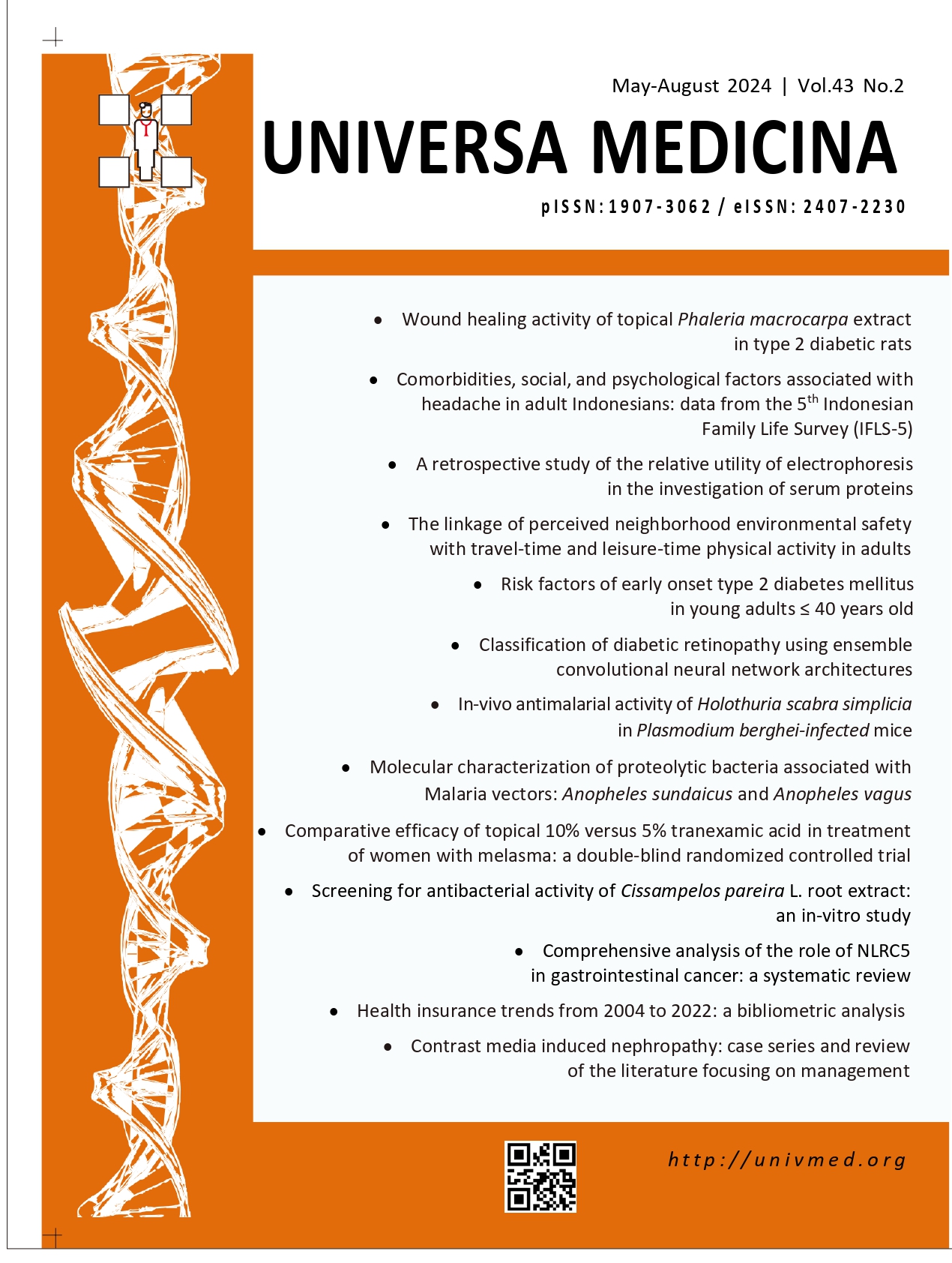Comparative efficacy of topical 10% versus 5% tranexamic acid in treatment of women with melasma: a double-blind randomized controlled trial
Main Article Content
Abstract
Background
Melasma is a highly prevalent chronic pigmentary disorder. The pathogenesis is unknown but melasma often occurs in photo-exposed areas, e.g., cheeks, upper lip, chin, and forehead. Tranexamic acid (TA), a plasmin inhibitor, aids in the inhibition of UV-induced plasmin activity and melanogenesis, making it a favorable therapeutic option for melasma. Tranexamic acid may be administered through various routes, e.g., topical. This study aimed to compare the efficacy of topical 10% versus 5% TA in women with melasma.
Methods
This double-blind randomized controlled trial included 16 females with epidermal type melasma who were randomized into two groups to receive either topical 10% TA (n = 8) or 5% TA (n = 8) applied twice daily for eight weeks. Prior to intervention and at 8 weeks after intervention, the intensity and extension of melasma were assessed based on melasma area and severity index (MASI) score and pigmentation score.
Results
Mean MASI and pigmentation scores in both treatment groups were similar at base-line (p>0.05). The reduction in MASI and pigmentation scores in the topical 10% TA and 5% TA groups was similar and statistically not significant after 4 and 8 weeks of treatment (p>0.05). There were no drug-related adverse reactions or complications.
Conclusion
This study demonstrated that topical 10% TA and 5% TA were effective in treating women with melasma. The utilization of topical 5% TA for melasma is a promising alternative therapeutic option without the need to increase the concentration of the formulation.
Article Details
Issue
Section

This work is licensed under a Creative Commons Attribution-NonCommercial-ShareAlike 4.0 International License.
The journal allows the authors to hold the copyright without restrictions and allow the authors to retain publishing rights without restrictions.
How to Cite
References
Rodrigues M, Pandya AG. Hypermelanoses. In: Kang S, Amagai M, Bruckner AL, et al., editors. Fitzpatrick's dermatology 9th ed. New York: McGraw Hill; 2019. pp. 1361–40.
Panchal VS, Patel YS, Dalal YD, Parikh AP, Dalal AD, Rana DA. Efficacy of oral, topical, and intradermal tranexamic acid in patients with melasma – a meta-analysis. Indian Dermatol Online J 2024;15:55–63. doi: 10.4103/idoj.idoj_495_22.
Mawu F, Kapantow G. Melasma. In: Mawu F, Kapantow G, editors. Kelainan pigmentasi kulit. [Disorders of skin pigmentation]. Manado: Unsrat Press; 2020. pp. 77–87.
Majid I, Aleem S. Melasma: update on epidemiology, clinical presentation, assessment, and scoring. J Skin Stem Cell 2021;8:e120283. doi: 10.5812/jssc.120283.
Murlistayrini S, Nugrahani AF, Rahmawati YD, Wilanti NW. Studi retrospektif: profil melasma di rumah sakit dr. Saiful Anwar Malang periode 2015-2017. [Retrospective study: Melasma profile in dr. Saiful Anwar Hospital, Malang, for 2015-2017.] J Dermatol Venereol Aesthetic 2020;1:95-103. Indonesian.
Taraz M, Niknam S, Ehsani AH. Tranexamic acid in treatment of melasma: A comprehensive review of clinical studies. Dermatol Ther 2017;e12465. doi: 10.1111/dth.12465.
Atefi N, Dalvand B, Ghassemi M, Mehran G, Hedarian A. Therapeutic effects of topical tranexamic acid in comparison with hydroquinone in treatment of women with melasma. Dermatol Ther 2017;7:417-24. doi: 10.1007/s13555-017-0195-0.
Janney MS, Subramaniyan R, Dabas R, Lal S, Das NM, Godara SK. A randomized controlled study comparing the efficacy of topical 5% tranexamic acid solution versus 3% hydroquinone cream in melasma. J Cutan Aesthet Surg 2019;12:63-7. doi: 10.4103/JCAS.JCAS_40_18.
Nair A, Jacob S, Al-Dhubiab B, Attimarad M, Harsha S. Basic considerations in the dermatokinetics of topical formulations. Braz J Pharm Sci 2013;49:423-34. doi: 10.1590/S1984-82502013000300004.
Do LHD, Law RM, Maibach HI. Dose response effect of chemical surface concentration on percutaneous penetration in human: In vivo + in vitro. Regul Toxicol Pharmacol 2022;132:105186. doi: 10.1016/j.yrtph.2022.105186.
Saka S, Rao GRR, Komaram RB, Kotha S, Tatavarthi R, Chitturi LP. Efficacy of 10% topical tranexamic acid in melasma – a randomized placebo-controlled split face study. Int J Pharm Sci Res 2019;10:2583-86. doi: 10.13040/IJPSR.0975-8232.10(5).2583-86.
Pandya AG, Hynan LS, Bhore R, et al. Reliability assessment and validation of the melasma area and severity index (MASI) and a new modified MASI scoring method. J Am Acad Dermatol 2010;64:78-83. doi: 10.1016/j.jaad.2009.10.051.
Rapalli VK, Singhvi G. Dermato-pharmacokinetic: assessment tools for topically applied dosage forms. Expert Opin Drug Deliv 2021;18:423-6. doi: 10.1080/17425247.2021.1856071.
Zhao L, Chen J, Bai B, et al. Topical drug delivery strategies for enhancing drug effectiveness by skin barriers, drug delivery systems and individualized dosing. Front Pharmacol 2024;14:1333986. doi: 10.3389/fphar.2023.1333986.
Liang R, Luo H, Pan W, et al. Comparative efficacy and safety of tranexamic acid for melasma by different administration methods: a systematic review and network meta-analysis. J Cosmet Dermatol 2024;23:1150-64. doi: 10.1111/jocd.16104.
Anwar AI, Wahab S, Widita W, Nurdin AR, Budhiani S, Seweng A. Randomized control trial outcomes of tranexamic acid combination serum as a depigmenting agent for the use in healthy individuals. Dermatol Ther 2019;32:e13146. doi: 10.1111/dth.13146.
Arora R, Sharma R. Study on effectiveness and safety of combination of daily 10% tranexamic acid gel application and weekly iontophoresis versus daily 10% tranexamic acid gel alone in treatment of melasma. Galore Int J Health Sci Res 2019;4:99–106.
Maeda K. Mechanism of action of topical tranexamic acid in the treatment of melasma and sun-induced skin hyperpigmentation. Cosmetics 2022;9: 108. doi: 10.3390/cosmetics9050108.
Zhang L, Tan WQ, Fang QQ, et al. Tranexamic acid for adults with melasma: a systematic review and meta-analysis. Biomed Res Int 2018:1–13. doi: 10.1155/2018/1683414.
Forbat E, Al-Niaimi F, Ali FR. The emerging importance of tranexamic acid in dermatology. Clin Exp Dermatol 2020;45:445-9. doi: 10.1111/ced.14115.
Sarkar R, Narayan RV, Vinay K, et al. Prescribing practices of tranexamic acid for melasma: Delphi consensus from the Pigmentary Disorders Society. Indian J Dermatol Venereol Leprol 2023;90:41-5. doi: 10.25259/IJDVL_1157_2022.
Pratama L, Murlistyarini S. Tranexamic acid in dermatology: a review. Jurnal Klinik Riset Kesehatan 2022;1:172-8. doi: 10.11594/jk-risk.01.3.5.
Kim SJ, Park JY, Shibata T, Fujiwara R, Kang HY. Efficacy and possible mechanisms of topical tranexamic acid in melasma. Clin Exp Dermatol 2016;41:480-5. doi: 10.1111/ced.12835.


